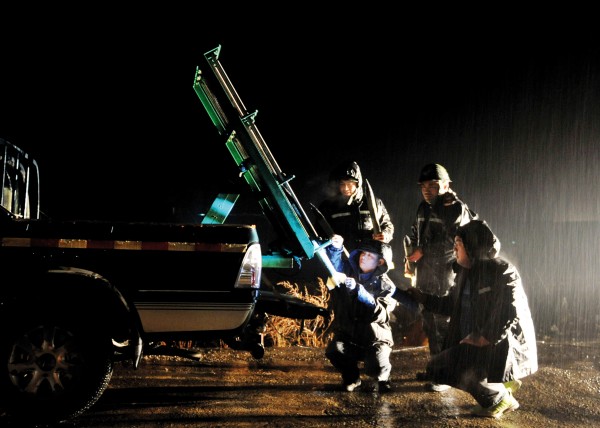Ice blocks
The oldest Blocks hailstorm occurred in Yorkshire 160 million years ago. The marks it made in the mud have been fossilised and preserved as stone. But it is only since the development of agriculture, about seven thousand years ago, that hail has become a serious threat to our food supplies.
Hailstorms can be immensely destructive, flattening acres of crops or stripping the vegetation off trees in a few minutes. On one occasion in Hawkes Bay, particularly jagged hailstones sliced apples in two and left halves hanging from trees.
One of the most costly hailstorms to have occurred in New Zealand was estimated to have lost kiwifruit growers six million dollars in the Bay of Plenty in 1987. A hailstorm in Hawkes Bay in 1986 did about four million dollars’ worth of damage to horticultural crops only two months after farmers had voted to cancel a hail insurance scheme—because it was too expensive!
Substantial hail damage also occurs in cities. The devastating Munich hailstorm of 1984 caused an insurance loss of over $US500 million, chiefly to cars. In Sydney, a hailstorm in 1976 led to insurance claims in excess of $A40 million.
Hail also poses a direct threat to life, as a blow on the head from a large hailstone can kill. Although there are no records of people being killed by hail in New Zealand, hailstones up to the size of tennis balls have been recorded here. Among the animals killed have been dogs, rabbits, sheep, chickens, ducks, seagulls and, on one occasion, a goldfish.
Deaths have occurred in a number of overseas countries, including the USA, China and India. One of the worst hailstorms on record occurred in Northern India in 1888. The hailstones were as large as cricket balls, and 246 people were killed, along with 1600 sheep and goats.
Hailstones grow in parts of cumulonimbus clouds where there is an abundant supply of droplets of liquid water at below zero temperatures. These liquid droplets freeze as soon as they touch an initial ice particle which itself will have formed on a freezing nucleus such as a speck of dust.
Occasionally, insects may act as freezing nuclei and then become entombed as the hailstone grows around them. Dead flies have been found inside hailstones in New Zealand.
On one occasion, in Iowa in 1882, live frogs were found inside two hailstones.
As the droplets freeze on to the growing hailstone, air is trapped between them. This gives them their white appearance. Sometimes the hailstone will partially melt as it grows, before going through another cycle of growth. This gives the hailstone a series of growth rings, like tree-rings, and these can be seen if the hailstone is sliced open.
The cumulonimbus updraught has to be strong enough to support the hailstone against the force of gravity. One way to get strong updraughts is with a supercell. This type of cumulonimbus can develop when the winds aloft are stronger than the winds near the ground. When this happens the cumulonimbus cloud grows up tilted at an angle to the vertical. Because of this, the vigorous updraught that creates the cloud is not destroyed by the rain it creates.
Normally, falling rain will destroy an updraught through friction and through the cooling caused by partial evaporation of the rain. When the tall cumulonimbus cloud is tilted, the rain falls to one side of the updraught, allowing the updraught to continue unhindered.
Ordinary cumulonimbus have a lifetime of about one hour, but supercells last longer and have much stronger up draughts, and hence can support hail until it has grown to appreciable size.
If all sizes of hail are considered, the greatest frequency occurs in western areas of New Zealand in winter and spring. But if only severe storms with large hailstones are considered, then the greatest frequency is in eastern districts in spring and summer.
Storms that produce small hail often affect large areas at the same time, but the most severe storms with the largest hailstones typically have narrow paths of destruction through a province, and most people are unaffected. For this reason they can only be precisely predicted a few hours ahead, with the use of weather radar.
Because hail can be so destructive, crop farmers and orchardists have long sought to prevent it. Artillery shells filled with cloud-seeding chemicals are fired into thunderstorms in Russia to try to make lots of little hail stones instead of a few large damaging ones. Hail cannon that fire a blank charge have been used in many countries, including New Zealand, with the hope that the shock wave will break up the hail stones.
However, this method has been compared by one expert to taking a block of ice from the fridge and trying to break it by yelling at it. The success of hail suppression is hard to judge, because it is hard to tell if there would have been a hailstorm had the cannon or artillery not been fired.
Although guns have been fired at the weather for hundreds of years, attempts at hail prevention go even further back. Church bells were rung as early as the 8th century to exorcise the evil spirits in clouds. A risky business, since bell towers were prime targets for lightning. Before this, arrows were sometimes shot into the clouds, perhaps to vent frustration as much as to skewer evil spirits.
Even in fine weather we are not completely safe, because large chunks of ice have been known to fall from a blue sky. The most likely explanation is that the ice formed on an aircraft and only fell off after the plane had left the cloud far behind.
Perhaps the most macabre “hailstone” to have fallen to Earth occurred in Germany in 1930. A glider pilot baled out of his glider in a thunderstorm over the Rhon mountains. The updraughts in the cloud held him aloft until he froze to death. By the time he fell to Earth he was encased in ice.
Hail is hard to study because it melts so fast. So, if you find some unusual hail, pop it in the freezer and ring the Meteorological Service.

















